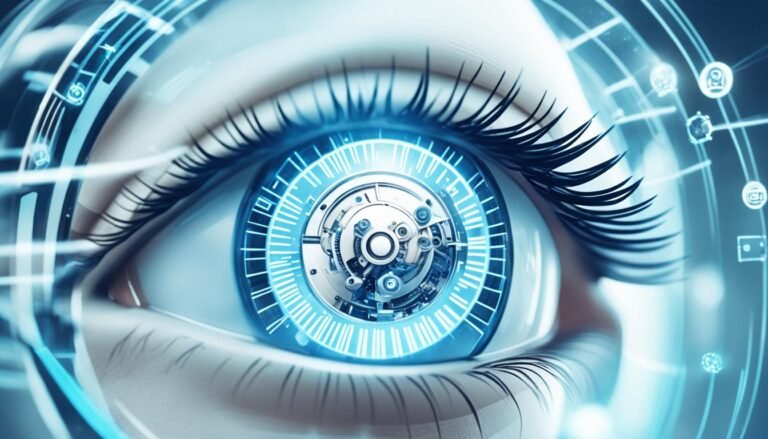Generative AI: The impact of generative AI tools like ChatGPT on various industries.
Did you know that the use of generative AI has grown more than twice in the last five years? Experts from McKinsey say that tools like ChatGPT and DALL-E could change many industries. Since it came out in November 2022, generative AI has made big strides. It’s now helping in fields like medical imaging and predicting the weather.
Key Takeaways:
- Generative AI adoption has more than doubled in the past five years.
- Generative AI tools like ChatGPT and image generator DALL-E have the potential to revolutionize various industries.
- Generative AI has shown positive impact in areas such as medical imaging analysis and weather forecasting.
Understanding Generative AI and its Development
Generative AI is a part of artificial intelligence that has become very popular lately. It can make new content by using advanced neural networks like GANs, transformers, and variational auto-encoders. This has changed how we use technology.
Generative AI systems can create things like text, images, videos, audio, code, or synthetic data. They learn from a lot of data using deep learning. This lets them do complex tasks that humans used to do.
To make generative AI models, they are trained on big datasets. They learn about patterns, styles, and what makes data similar. Then, they use this knowledge to make new content by predicting patterns and combining training data. This process helps them get better over time, making their results more realistic.
Generative AI has made artificial intelligence much more advanced. It lets machines think creatively and solve problems. This technology could change many industries, like entertainment, marketing, healthcare, and finance.
Evolution of Generative AI Models
Generative AI has changed a lot over time. Early models like RNNs and CNNs helped create more complex ones like GANs and transformers.
Generative AI models are different from old ones because they add randomness and creativity. This has opened up new ways to make content, change it, and make it personal.
GANs have two parts: a generator and a discriminator. They work against each other to make high-quality content. The generator tries to make things that look real, and the discriminator checks if they are real or not. This helps GANs make realistic images, videos, and text, which opens up new ways to be creative.
The Potential of Generative AI in Various Industries
Generative AI is changing many industries. In marketing, it helps make content, ads, and recommendations just for you. In healthcare, it’s good at analyzing medical images, finding new drugs, and making treatment plans just for you.
In entertainment and gaming, it helps make virtual characters and stories look real. The finance world uses it for spotting fraud, assessing risks, and modeling finances.
Generative AI is moving fast, which is exciting but also raises concerns about its use. We need to think carefully about its ethical and social effects before we use it more.
Next, we’ll look at how generative AI can change text-based machine learning. It could change how we analyze and create text.
The Potential of Generative AI in Text-Based Machine Learning
Text-based machine learning has seen big leaps forward, especially with generative AI models like ChatGPT. ChatGPT uses advanced methods to understand and create text that sounds like it was written by a human.
Generative AI in text-based machine learning is great at looking at lots of data and learning from it. ChatGPT uses self-supervised learning to go through huge amounts of text. This helps it get better at predicting what comes next in a sentence or paragraph. It learns about language, meanings, and the context of conversations, making its responses smart and clear.
Models like ChatGPT are really promising for many tasks, like writing content, finishing code, and simulating business scenarios. They can create articles, code, and even mimic complex business situations. This makes them useful for saving time and providing practical solutions.
Even though ChatGPT is impressive, it’s still being tested and improved. Sometimes, it might not get the context right or give accurate answers. So, it’s important to keep working on making these AI models better.
The Evolution of ChatGPT
ChatGPT marks a big step forward in text-based machine learning. It can understand, generate, and respond to text, opening up new possibilities for AI in communication.
OpenAI created ChatGPT, building on the work of earlier language models like GPT-3. But it’s more interactive and can respond better in conversations. Thanks to improvements and fine-tuning, ChatGPT is now a useful tool for chatting and getting information.
OpenAI is working hard to make ChatGPT better, focusing on avoiding biased or harmful responses. They want to make sure the AI is responsible and ethical. They listen to users to find and fix problems, making ChatGPT more trustworthy and ethical.
Generative AI models like ChatGPT could change how we use chatbots and virtual assistants. By making these models better, we can improve their accuracy, understanding of language, and ability to get the context right.
Generative AI and text-based machine learning open up huge possibilities for new ideas and automation. As we move forward, we need to balance the benefits of technology with ethical concerns about AI.
In the next section, we’ll look at the challenges of building and using generative AI models. We’ll dive into the complexities of making these models work well.
Building Generative AI Models and its Challenges
Building generative AI models is both exciting and tough. It needs a lot of resources and know-how. Companies like OpenAI and DeepMind have put a lot into it. They’ve hired top talent and set up big teams to work on models like ChatGPT and DALL-E.
Creating these models begins with gathering a huge amount of data from the internet. This data is key for training the AI models. It helps them learn and produce coherent text or images. But, this method has its own problems, like making sure the data is good quality, diverse, and free from bias.
One big challenge is the need for a lot of computing power to train these AI models. Training them can take a long time, sometimes weeks or even months. They need access to powerful computers and special hardware.
Generative AI models also face the problem of not always producing accurate or reliable results. They can create content that looks very human-like. But, they might also make mistakes or produce wrong information. So, it’s important to check and fine-tune the models to make sure they work well.
Another big challenge is making these models better over time. The AI community is always working on improving them. They’re tweaking the models to make their outputs better, reduce bias, and work more effectively. This means a lot of research, testing, and working together within the AI field.
In the end, building generative AI models is a complex task that can really change many industries. But, we need to solve problems like getting good data, having enough computing power, making sure the outputs are right, and keeping improving the models. This will help us get the most out of generative AI.
Output Capabilities of Generative AI Models
Generative AI models have changed the game in content creation. They use advanced algorithms to make text, images, audio, video, and even code. This is thanks to their ability to process huge amounts of data.
ChatGPT is a great example of this. It can write detailed essays, articles, recipes, and more. It does this by mimicking human language and style. This makes it useful in many industries, from journalism to creative writing.
The quality of what generative AI models produce depends on several things. This includes the model’s skills and the input it gets. The quality also depends on the training data and the task at hand.
Generative AI isn’t just about text. Models like DALL-E can create unique and artistic images. Users can use prompts to get imaginative visuals. This shows how generative AI can change the creative arts.
But, it’s important to know that generative AI isn’t perfect. It can show biases or errors because of its training data. Researchers are working hard to fix these issues and make sure the outputs are fair.
Generative AI has many uses across different industries. It can make personalized content for marketing or automate content for news outlets. This could make processes faster and more efficient.
To get the most out of generative AI, we need to find a balance. We should use AI’s creativity with human expertise. This way, we can achieve amazing results in content creation.
Applications and Impacts of Generative AI in Various Industries
Generative AI is changing the game in many industries. It’s making a big splash in healthcare, customer service, finance, marketing, and supply chain management. Let’s dive into how generative AI is making a big difference in each area.
Healthcare
In healthcare, generative AI is a game-changer. It helps improve medical imaging and diagnosis. By creating realistic images, it trains AI tools to spot diseases early and accurately. This means better health outcomes and smarter treatment plans for patients.
Customer Service
Generative AI has changed customer service for the better. It brings us AI chatbots that offer personalized help right away. These chatbots handle simple questions and give focused support, making customers happier and saving companies money.
Finance
The finance world is also benefiting from generative AI. It makes financial reports more accurate and efficient. This lets financial experts focus on big decisions. Plus, it helps predict market trends, improve trading, and lower risks.
Marketing
Marketing is getting a boost from generative AI too. It offers deep insights into what customers want. With these insights, marketers can tailor their strategies to hit the mark. This means better campaigns and more engaged customers.
Supply Chain Management
Generative AI is making a mark in supply chain management. It helps predict demand better, helping companies manage their stock and streamline production. It also improves communication and teamwork in the supply chain, making things run smoother.
As generative AI grows, its impact on industries is clear. It’s helping with accurate diagnoses in healthcare and improving customer service. By using generative AI, companies can innovate and work more efficiently across different sectors.
The Economic Impact of Generative AI and Workforce Transformation
Generative AI can change industries and the global economy. It can add trillions of dollars in value every year. This technology makes things more creative and human-like.
Experts say Generative AI could add $2.6 trillion to $4.4 trillion a year. This comes from making things more efficient and innovative. It boosts productivity and efficiency across many sectors.
Generative AI changes the workforce by automating simple tasks. This lets workers focus on creative and strategic tasks. It helps them develop skills for complex challenges and innovation.
But, we need to invest in training workers for these changes. This ensures they can keep up with new technologies. With the right tools and knowledge, workers and companies can use Generative AI fully.
Using Generative AI in businesses makes workers more productive. This leads to economic growth for companies and the whole economy. It automates simple tasks and boosts worker skills, making operations more efficient.
Investing in the Workforce for Economic Success
To make the most of Generative AI, we must tackle challenges and support workers. This means offering training, a supportive work environment, and ongoing learning chances.
By training a skilled workforce, companies can use Generative AI to innovate and stand out. This partnership between AI and human skills can create new value. It can lead to economic growth and prosperity worldwide.
Conclusion
Generative AI, with tools like ChatGPT, is changing many industries. It’s making businesses work better and improving how they serve customers. This technology is a big deal in healthcare and finance.
But, we’re just starting with generative AI. As it grows, we need to tackle the challenges it brings. It’s important for everyone to work together on this.
There are ethical concerns, like how AI might have biases. We also need to think about how it will change jobs. As AI takes over some tasks, people will need new skills.
In the end, generative AI is very promising for the future. It’s clear it will help industries grow and change the economy. But, we must use it wisely. We should focus on ethics, prepare for job changes, and help people learn new skills. This way, we can make the most of AI and create a better future.







